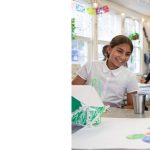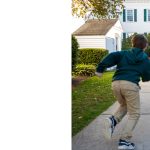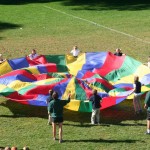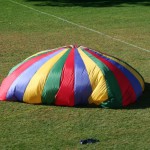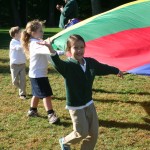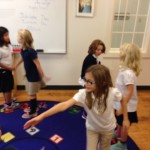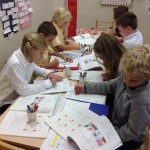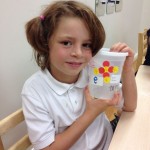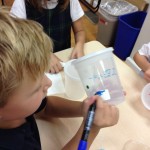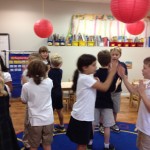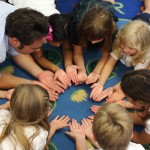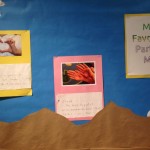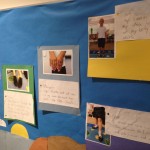Parachute Games
Posted by Sarah PollexOne of the “Fun Friday” activities for first and second grade this month was parachute games. While these games require muscular strength and endurance, cooperation is key to making them work. The students first mimicked a merry go round, moving the parachute clockwise and counterclockwise as they walked, ran and skipped. Using a variety of arm movements, the students then rippled small, medium, and large “waves.” Afterwards, they popped “popcorn” by shaking small balls on the surface of the parachute. Finally, the students made a “mushroom.” Inside, they played high-five and finished with a Go Gators! cheer. While the students acknowledged their tired deltoids, biceps, and triceps, the muscle that got the biggest workout were the abdominals–from all the laughter!
“Shake Hands, now move to the next one!”
Posted by Megan KirkStudents in second grade have been working on their folk dancing! Dance is an extremely important element of music class. It helps students feel and move to music. We have been learning many new dance steps that take a lot of focus, working as a team and of course listening and feeling the beat of the music. One of the more difficult steps has been our circle weave. Students have four beats to “Shake hands, now move to the next one.” We started by learning the basic count of the step, then added the words to help students know where they were going. After we were comfortable with the steps, it was time to just hear the music and feel the four beat patterns on their own! We had to keep practicing, but finally we all were able to successfully get all the way around the circle!
How Do We Learn Chinese?
Posted by Teresa HsiaoSecond graders have been exploring different ways to sharpen their oral and written language skills in Chinese as a team. They practiced counting fluently in Chinese by playing patty cake and exercised their brain muscles with rounds of Heart Attack card game in Chinese! They also have been racing to learn how to write Chinese characters in proper stroke orders so that they could earn money for their “bank accounts.” It is impressive how our eager learners incorporated various Chinese characters they know or want to learn when they decorated their own piggy banks and how quickly they learned to enter into their bank account ledgers by recording dates and adding up the balance in Chinese. By the end of September, the class has come together as a cohesive learning community where students feel safe to take learning risks together and are ready to help each other to learn more Chinese!
Guess What This Is?
Posted by Alyson CahillIn second grade drama, students took turns imagining that a simple object – in this case, a bean bag – could be transformed into something entirely different. Each student used their bodies and facial expressions to turn the bean bag into a guitar, a soccer ball and even a cat! They did a great job brushing up on their pantomime skills and ability to use non-verbal communication. In this picture, one student is very carefully decorating a cake with her “pastry bag!” 
Multicultural Approach Starts with Self
Posted by Cameron Ross-MacCormackAs a starting point to building an inclusive classroom community we spent some time investigating ourselves and each other. There are many ways to be human and multiple perspectives or lenses through which we see the world. “My Favorite Part of Me” and “Self Portraits” are two assignments matched with “I Like Myself” by Karen Beaumont. Above, we observe our many pigment variations to help with color mixing in a very matter-of-fact way before starting our self portraits. Below are a few examples of our work.
Sol, La and Mi
Posted by Megan KirkOne of the ways students learn to read music is by learning solfege – do, re, mi, fa, sol, la, ti, do. You might recognize these names from Sound of Music! In class we have been working on sol, la, and mi. First we sang a song that used these three pitches, and then we used the boomwackers to play the song! Students are also identifying that sol to la is a step in music, while sol to mi is a skip. All of this will build a great foundation in their abilities to sight read music!










